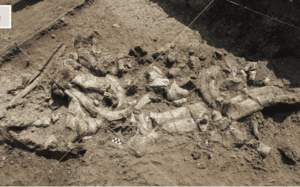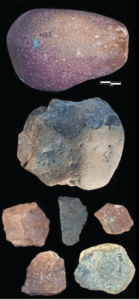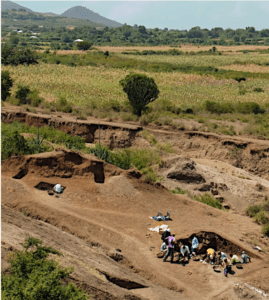
As researchers tirelessly excavate archaeological finds all over the world, they continue to make new discoveries about humanity’s past. One such discovery was recently made by a team working in Kenya, who uncovered a site that shed light on the behaviors of our ancient relatives, Paranthropus. Although not a direct ancestor of Homo sapiens, these ancient cousins appear to have possessed the ability to make stone tools and use them to butcher one of their food sources, the hippopotamus.
Oldowan tools
Previously, it was believed that Homo habilis was responsible for producing Oldowan tools. However, this theory was invalidated when tools were discovered that were older than the youngest known Homo habilis specimens. While it’s possible that Homo habilis adopted this technology, they were not the original inventors. According to researchers, it’s more probable that one of the Australopithecus species, which had a sufficiently large brain size, created these tools.

Examples of Oldowan tools from the Nyayanga site
The durability of Oldowan tools, which were crafted from rock, is evident by their survival over time. While it’s possible that wooden tools were also utilized, their decomposition over the millennia makes their existence uncertain. Oldowan tools were fashioned by flaking stones to create cutters, choppers, and scrapers, which were essential for various tasks carried out by our early human ancestors, such as eating, food preparation, construction, and working with animal hides.
Discovery in Nyayanga
These tools changed everything for human ancestors as they allowed for the consumption of foods that they physically couldn’t eat before. Involved in the discovery, Rick Potts said, “With these tools you can crush better than an elephant’s molar can and cut better than a lion’s canine can (…) [it] was like suddenly evolving a brand-new set of teeth outside your body, and it opened up a new variety of foods on the African savannah to our ancestors.”

Satellite image of Lake Turkana, with Lomekwi, one of the important Kenyan archaeological sites, located on the western bank
Although it is still nearly impossible to tell who created the first Oldowan tools, the discovery at the Nyayanga archaeological site certainly helps clear things up. Located on the Homa Peninsula in western Kenya, the site contained 330 stone tools that were roughly dated to 2.9 million years ago – although they could be anywhere between 2.6 and three million years old.
Raising new questions
The discovery of these ancient tools is significant as they are among the oldest ever found. However, what makes this finding even more remarkable is that no Homo fossils were found in the vicinity. Instead, the researchers uncovered two molars from a Paranthropus individual in close proximity to the tools. Although Paranthropus is classified as an Australopithecine and is part of the broader human family tree, it is not believed to be a direct ancestor of modern humans.

Nyayanga site being excavated in July 2016
Thomas Plummer was the lead anthropologist involved in the research and subsequent publication in the Science journal. Of the discovery he said, “The association of these Nyayanga tools with Paranthropus may reopen the case as to who made the oldest Oldowan tools. Perhaps not only Homo, but other kinds of hominins were processing food with Oldowan technology.”
A butcher shop
This could mean that Paranthropus was the original maker of the tools, or it could mean that many species were making them at the same time. Incredibly, alongside the teeth and the stone implements, researchers also found the remains of three hippos. After analysis, it became clear that at least some Oldowan tools had been used on two of the animals.

Drawing of a hippopotamus skeleton like was discovered in Kenya.
There were a variety of different cut marks on their bones, a deep one on a rib fragment, and four shorter ones on a shin bone. As well as the hippos, there were also the remains of an antelope whose bones had clearly been crushed to access the edible marrow. Overall the site contained a total of 1,776 animal bones, leading the team to believe that they discovered a “prehistoric butcher shop.”
Paranthropus
Aside from the evidence on the bones, the team also conducted an analysis of the wear patterns present on 30 of the tools to see just how they were used. They realized that they weren’t just designed to butcher animals, but also to process plants – likely using them to peel away the tough outer layer of roots. It’s not clear exactly how Paranthropus prepared this food for consumption as their use of fire was still two million years away, but they very well could have pounded it down to make it easier to eat.

Reconstructed model of what the early hominin Paranthropus boisei is believed to look like
Certain researchers, including Mohamed Sahnouni, a paleolithic archaeologist in Spain, have voiced their dissent regarding the notion that Paranthropus was responsible for creating Oldowan tools. Sahnouni argues that it seems improbable because the anatomy of Paranthropus was already well-suited for consuming coarse foods, which means they would not require tools designed to process such foods.
More from us: Decapitated Crocodiles Discovered in Undisturbed Ancient Tomb Were Mummified in an Unusual Way
Despite this, he is still excited about the finding, as it reveals that animals were being butchered by human ancestors 600,000 years before researchers once thought. Although this study doesn’t conclusively answer the question of who really created Oldowan tools, it certainly provides a wealth of new information on how humanity’s ancient cousins lived, butchered, and ate.





